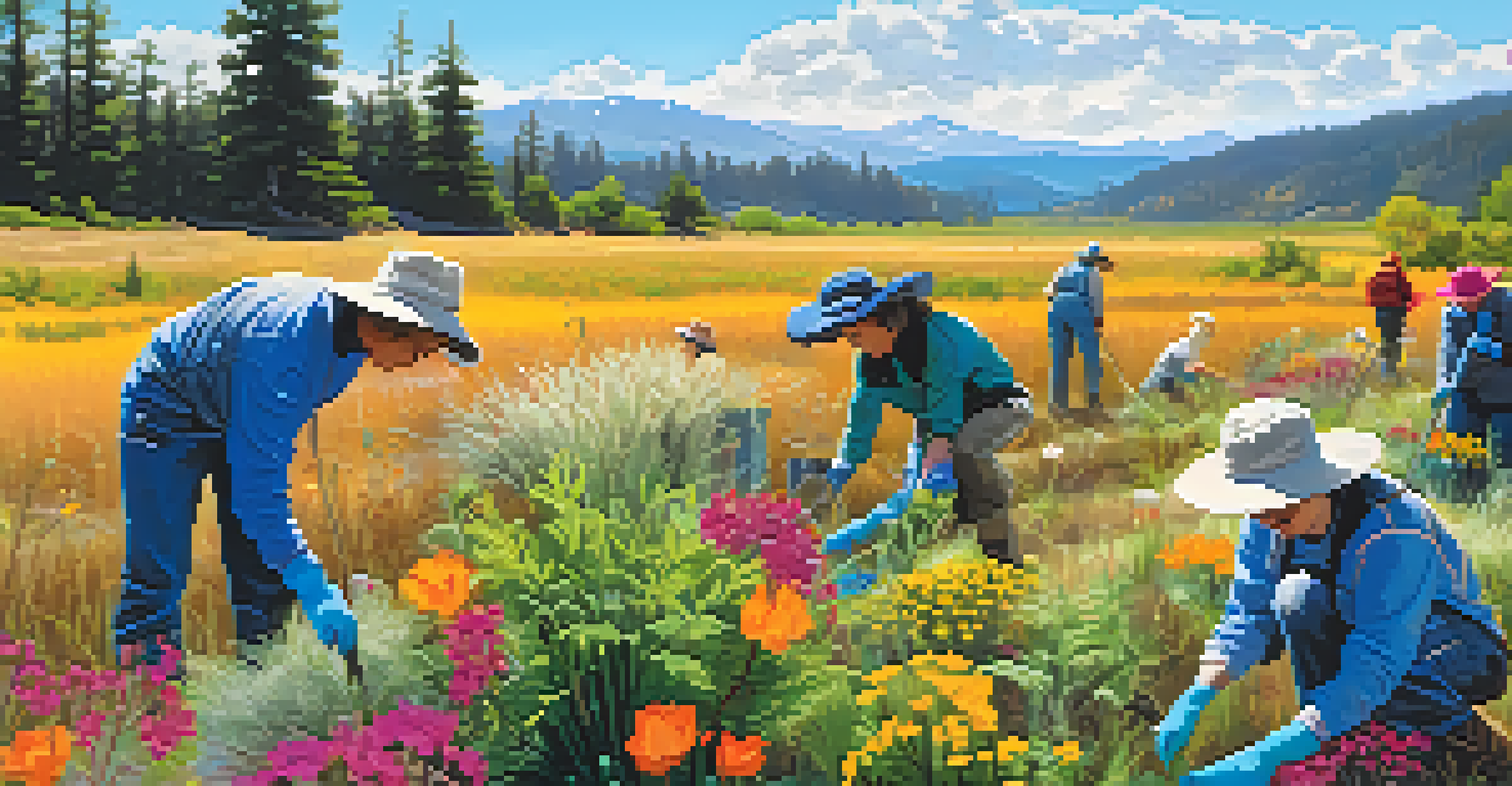Oregon's Wildlife Corridors: Ensuring Safe Animal Passage

Understanding Wildlife Corridors and Their Importance
Wildlife corridors are essential pathways that allow animals to move safely between habitats. These routes help prevent isolated populations, which can lead to genetic bottlenecks and reduced biodiversity. By connecting various ecosystems, corridors play a critical role in the survival of many species, allowing them to find food, mates, and shelter.
Wildlife corridors are not just essential for wildlife; they are vital for our ecosystems and the health of our planet.
In Oregon, wildlife corridors are especially important due to the state's diverse landscapes, which include forests, mountains, and rivers. These natural features can create barriers for wildlife, making it challenging for them to migrate freely. By establishing designated corridors, we can ensure that animals can traverse the landscape without facing dangerous obstacles like highways or urban developments.
Moreover, wildlife corridors are not only beneficial for animals but also for humans. They can help reduce vehicle collisions with wildlife, which can be costly and dangerous. Encouraging safe animal passage ultimately leads to healthier ecosystems, which support tourism and recreational activities in Oregon.
Key Challenges Facing Oregon's Wildlife Corridors
Despite their importance, Oregon's wildlife corridors face several challenges. Urban expansion and infrastructure development often fragment these pathways, making it difficult for animals to navigate through their natural habitats. This fragmentation can lead to increased mortality rates as wildlife attempts to cross busy roadways or navigate through less hospitable areas.

Climate change also poses a significant threat to wildlife corridors. As temperatures rise and weather patterns shift, many species may need to relocate to survive, further complicating their movement across fragmented landscapes. The changing environment can alter the availability of food and water sources, forcing animals to seek new habitats, which may not be easily accessible.
Wildlife Corridors Enhance Biodiversity
Connecting habitats through wildlife corridors is crucial for preventing genetic isolation and supporting diverse ecosystems.
Additionally, human activities such as logging, agriculture, and mining can disrupt animal migration routes. These activities not only alter the landscape but also introduce pollutants that can affect wildlife health. Addressing these challenges requires a collaborative effort among conservationists, local communities, and policymakers to protect and restore these vital corridors.
Successful Examples of Wildlife Corridor Projects in Oregon
Oregon has seen some successful initiatives aimed at establishing and enhancing wildlife corridors. One notable project is the Oregon Department of Transportation's efforts to create wildlife crossings along highways. These crossings, which include overpasses and underpasses, have been designed to facilitate safe animal movement while minimizing human-wildlife conflict.
The future will be shaped by the decisions we make today, especially regarding conservation and the preservation of wildlife habitats.
Another example is the work done by conservation organizations such as the Oregon Wildlife Foundation. They have partnered with local governments to restore habitats and create corridors that connect fragmented landscapes. By planting native vegetation and removing barriers, these projects have improved the chances for wildlife to thrive in their natural environments.
These successful projects serve as a model for other states facing similar challenges. They demonstrate that collaboration between government agencies, nonprofits, and the community can lead to effective solutions for wildlife conservation. As awareness grows about the importance of these corridors, more initiatives are likely to emerge, further protecting Oregon's wildlife.
The Role of Communities in Supporting Wildlife Corridors
Local communities play a crucial role in the success of wildlife corridors. Engaging residents in conservation efforts can foster a sense of stewardship and responsibility for local wildlife. Community members can participate in initiatives such as habitat restoration projects, which help enhance the connectivity of these corridors.
Education is another vital component. By raising awareness about the importance of wildlife corridors, communities can encourage more people to support conservation efforts. Schools, local organizations, and social media can serve as platforms to share information and inspire action, making wildlife protection a shared community goal.
Community Involvement is Key
Local communities play a vital role in supporting wildlife corridors through conservation efforts, education, and advocacy.
Additionally, communities can advocate for policies that prioritize wildlife corridors in urban planning. By voicing their support for sustainable development practices, residents can help ensure that future projects consider the needs of local wildlife. This grassroots involvement is essential for creating a lasting impact on the preservation of Oregon's natural habitats.
Innovative Technologies Supporting Wildlife Corridor Planning
The advancement of technology has revolutionized how we approach wildlife corridor planning. Geographic Information Systems (GIS) allow researchers and conservationists to analyze landscapes and identify critical areas for wildlife movement. By mapping out existing habitats and human developments, they can pinpoint where corridors are most needed.
Camera traps and wildlife tracking devices have also become invaluable tools. These technologies help researchers monitor animal movements and behavior, providing insight into how effectively corridors are functioning. By gathering data on species interactions and migration patterns, scientists can make informed decisions about how to improve these pathways.
Moreover, drones are increasingly being used to assess landscapes and monitor restoration projects. This aerial perspective allows for a better understanding of habitat connectivity and the impact of human activities on wildlife corridors. As these technologies continue to evolve, they will play a pivotal role in enhancing the effectiveness of wildlife conservation efforts in Oregon.
Government Policies Promoting Wildlife Corridor Conservation
Effective government policies are essential for the successful implementation of wildlife corridors in Oregon. Local, state, and federal laws can establish guidelines for land use and conservation efforts, ensuring that wildlife corridors are protected. By prioritizing these areas in planning processes, governments can facilitate the safe movement of wildlife across landscapes.
Programs such as the Oregon Conservation Strategy aim to address the challenges facing wildlife and their habitats. This strategy includes measures to protect and enhance wildlife corridors, recognizing their significance in maintaining biodiversity. By integrating wildlife needs into land management practices, Oregon is paving the way for a more sustainable future.
Technology Aids Corridor Planning
Innovative technologies like GIS and wildlife tracking devices are essential for identifying and improving effective wildlife corridors.
Furthermore, funding for conservation initiatives can be bolstered through grants and partnerships. By collaborating with organizations dedicated to wildlife protection, governments can leverage resources to implement effective corridor projects. Such efforts not only benefit wildlife but also contribute to the overall health of Oregon's ecosystems.
The Future of Wildlife Corridors in Oregon
Looking ahead, the future of wildlife corridors in Oregon will depend on continued collaboration among various stakeholders. Conservationists, government agencies, and local communities must work together to ensure that these vital pathways are maintained and expanded. As awareness of the importance of wildlife corridors grows, so too does the potential for innovative solutions.
Climate change will undoubtedly challenge the effectiveness of existing corridors, prompting the need for adaptive management strategies. By continually assessing and adjusting these pathways, we can better meet the needs of wildlife in a changing environment. This proactive approach will be essential in safeguarding Oregon's biodiversity for generations to come.

Ultimately, the success of wildlife corridors in Oregon will hinge on a collective commitment to protecting our natural heritage. By prioritizing the needs of both wildlife and communities, we can create a balanced approach that fosters coexistence and promotes the health of our ecosystems. Together, we can ensure that Oregon remains a sanctuary for its diverse wildlife.